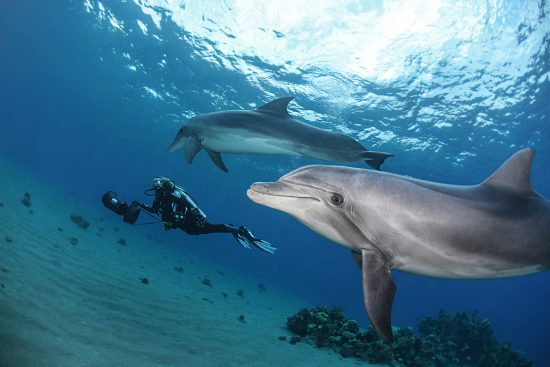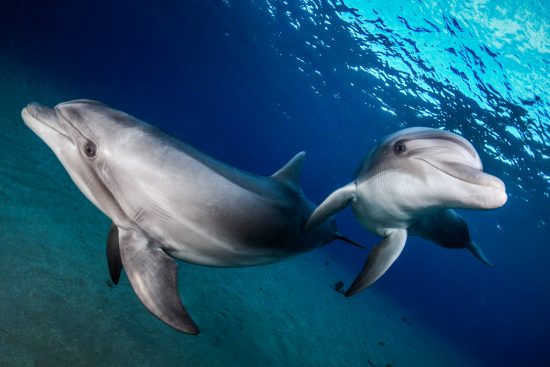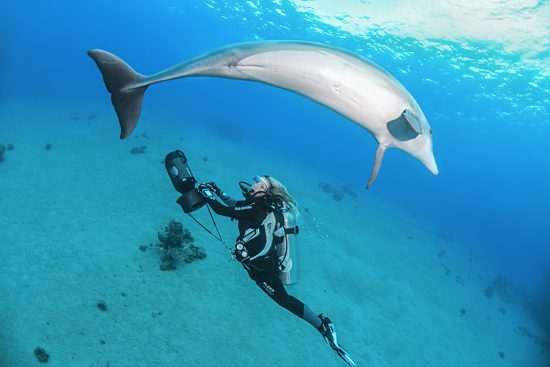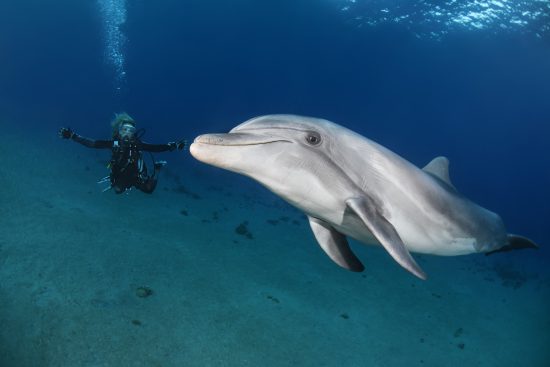






Everyone loves dolphins, and it is probably the dream of most divers to dive with dolphins, the most loved cetaceans. There are more than 40 dolphin species worldwide, most living in marine waters, except for four families of river dolphins living in large rivers such as the Amazon, Yangtze and the Ganges. Sadly, the Yangtze river dolphin has been officially extinct since 2006. There are 6 species of dolphins that are called blackfish which are: short and long-finned pilot whales, false killer whales, pygmy killer whales, killer whales and melon-headed whales.
Dolphins are 'odontocetes', tooted whales, grouped with porpoises (which are much smaller and chunkier). They have conical, flat teeth. Not all are small and cute - some can weigh up to 10 tonnes and are almost 10m long, with the largest being Orcas at 30 feet long, and the smallest, Maui dolphins, just over 1 meter long, weighing 50 kg. Dolphins are fast swimmers, reaching speeds at an average of 18 miles per hour (29km/h), but orcas can reach 55km/h when hunting. All have thick blubber that helps with thermoregulation and buoyancy.
Most dolphin species have a characteristic curved or hooked dorsal fin, but some species have no dorsal fin at all. As they are marine mammals, they need to come to the surface to breathe, using their blowholes to expel stale air from their lungs and take a fresh breath. They have a good sense of hearing and are not dependant on their sight for survival. They are also able to slow down their heart rate to conserve oxygen.
Their genitals are internal and, other than size in some species (females being bigger), the way to check if a dolphin is male or female is to observe how many genital slits are present. Males have two genital slits whereas females only have one. Females have calves every two to three years, but the males mate with a few females every year. Calves are born during the summer, and they stay with their mothers for a long period. Some dolphins mate with other species, there have been some hybrids recorded between Risso’s dolphins and bottlenose dolphins, common and bottlenose and Atlantic spotted and bottlenose. There is also a false killer whale and bottlenose hybrid called wolphin, and few have been observed living in the wild.
Their diet consists of mainly fish and squid which they find using echolocation. They use sound waves to get information on the size and location of the prey, producing sounds (clicks) that they bounce off objects. This makes them very sensitive to pressure changes and vibration. They also communicate by using squeaks, whistles and clicks, and it is thought that different dolphin pods use different dialects that are passed down from generation to generation. They are social creatures and usually live in pods of over 10, but can form super pods of over 1000 when hunting. There are several solitary dolphins around the world, and little is known about whether or not they choose to live alone or they were cast away from their communities.
While they are adored and revered by humanity, most species of dolphins are endangered, and their populations are diminishing because of habitat destruction, pollution and bycatch. In some countries, they are still being hunted for meat or to be sold live to aquariums. As they are top predators, they tend to bioaccumulate pollutants, and their meat is known to have very high levels of mercury. While females offload their pollutant burden when lactating their young, the males are not able to do so and suffer greatly from high levels of contaminants. While it is an amazing opportunity to see dolphins while diving, we need to be aware that these are wild animals and not always in a playful, good mood. Also, due to their size, they can cause harm without meaning to. We also have to be aware that they are mammals; therefore, the diseases affecting them can be passed to us, and we can also pass our bacteria and viruses on to them.
Text by Bogna Griffin, BSc Hons Freshwater and Marine Biology
Photos by Ivana OK & Janez Kranjc
 Ivana and Janez
Ivana and Janez 15th January 2021
15th January 2021